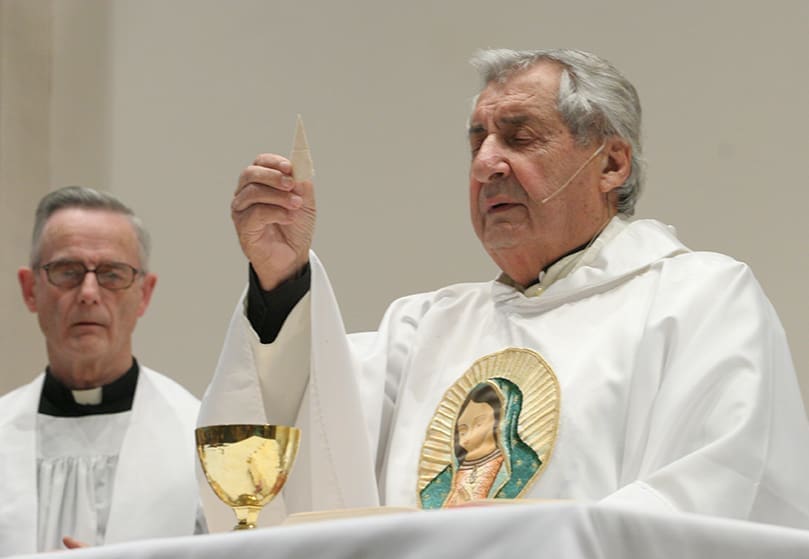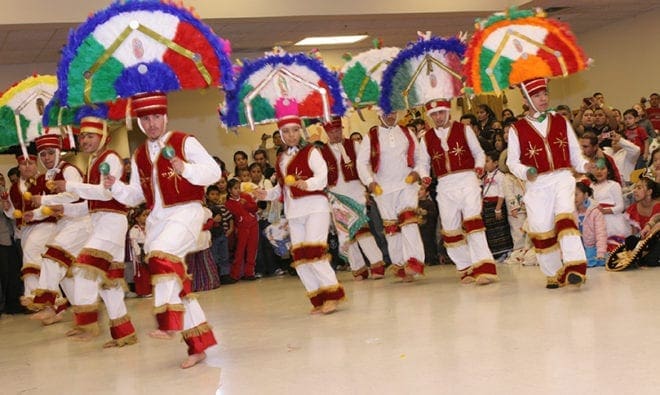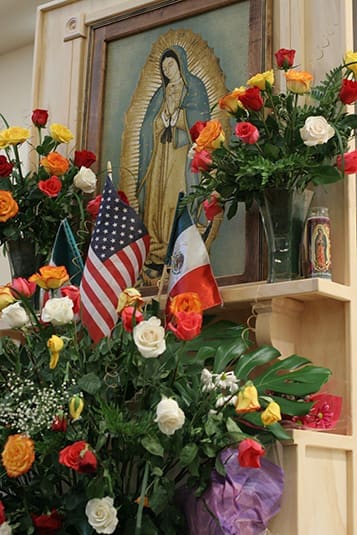 Photo By Michael Alexander
Photo By Michael AlexanderConyers
Catholics Around Archdiocese Honor Marian Feast Day
By STEPHEN O'KANE, Staff Writer | Published December 24, 2009
With coats on and hoods up, a dozen or so people stood in the chilly air outside the St. Pius X Church social hall, praying the rosary in Spanish before a shrine to Our Lady of Guadalupe. It was one of several shrines on the church’s grounds that day.
Meanwhile, others inside the social hall were preparing for a large dinner to follow the upcoming Mass. Hundreds of chairs waited to filled. The colors of Mexico’s flags were displayed everywhere, from the ceiling to the table centerpieces. Little ones laughed and cried as their parents helped with the setup. Another group hidden away practiced their folk dancing for the celebration.
A few drops of rain occasionally fell from the overcast sky as the rosary group continued their praying and singing. Above their heads celebration flags with Mexican colors whipped in the frequent gusts. After completing the rosary recitation, the group broke into a spirited rendition of “La Guadalupana.”
Hundreds more joined the celebration inside the sanctuary as the time for Mass neared. The bright colors of those in traditional Mexican dress were speckled throughout the dark shades of winter coats. Beforehand, confession was available in both Spanish and English for anyone who needed it.
A large shrine with the Guadalupe icon stood to the left of the altar, adorned with roses. People often stopped to add more flowers or to simply kneel and say a quick prayer.
About 500 were there Saturday, Dec. 12, to celebrate the feast of Our Lady of Guadalupe, a popular and significant event in Catholic history. The events in Conyers lasted most of the weekend, and throughout the Archdiocese of Atlanta parishes commemorated the feast day in their own ways.

Onlookers watch the cultural entertainment during the Our Lady of Guadalupe celebration in the parish hall of St. Pius X Church, Conyers. Photo By Michael Alexander
Father John Kieran, pastor of St. Pius X, said that the celebration this year was “very successful” for his parish—parishioners and non-parishioners came to celebrate this big feast day. A committee at the parish plans the entire event, he said, and arranges the various folk groups and dance groups that participate.
Father Kieran said that about 20 percent of his 1,700-family parish is Hispanic, and he is devoted to serving his Spanish community. He has learned to speak Spanish in the last four years and celebrates Mass in that language, as does the parochial vicar at St. Pius X, newly ordained Father Tim Gallagher, who studied in Mexico. Father Kieran said the new priest has a “real sensitivity” for the Hispanic community.
“It’s an amazing awareness,” said Davis, “for families to know about her as our Mother.”
She also held a special workshop on Our Lady of Guadalupe for students in her middle school program.
St. Pius X celebrates the feast day, Davis said, “in an exciting and meaningful way.”

A group of St. Pius X members who go by The Saint Michael Dancers perform before an enthusiastic crowd. Photo By Michael Alexander
From Carrollton to Marietta to Flowery Branch, Catholic communities celebrated with processions, dancing, prayer and Mass. Many parishes also participated in mañanitas, traditional Mexican songs that are sung early in the morning on special occasions. Often people are awakened with this song on their birthdays. Traditionally it is sung to Our Lady of Guadalupe on her feast day either at midnight or the break of dawn to greet her.
Atlanta Auxiliary Bishop Luis Zarama presided over Mass on Dec. 12 at Our Lady of the Americas Mission in Lilburn. The mission began its celebration on Tuesday with a novena of rosaries and finished Saturday evening with Mass and dancing.
Misión Católica San Felipe de Jesús in Forest Park began recognizing the feast day on Dec. 3, offering confession, rosary and the Eucharist every night until the actual feast on Dec. 12.
Other parishes, such as Good Shepherd Church, Cumming, offered dramatizations of the well-known story. The tradition tells of a man named Juan Diego, who saw a vision of the Virgin Mary at the Hill of Tepeyac during a walk to the city in 1531. Speaking a dialect of Aztecan, the woman asked for a church to be built at that site in her honor.
When Diego told his story to the Spanish bishop, Fray Juan de Zumárraga, he was asked to produce a miraculous sign to prove his claim. The Blessed Virgin asked Diego to gather some flowers at the top of Tepeyac Hill, even though it was winter and no flowers bloomed.

A portable shrine for Our Lady of Guadalupe was erected to the left of the St. Pius X altar for the Mass. Photo By Michael Alexander
Diego found Castilian roses at the site and gathered them to bring to Bishop Zumárraga. When he presented the roses to Bishop Zumárraga, the image of the Virgin of Guadalupe miraculously appeared imprinted on the cloth of his “tilma,” or cloak.
The Virgin of Guadalupe has always been spiritually close to the people of Latin America, particularly the Mexican people, but popes have reminded all in North and South America that she is significant to them. She has been given the title “Patroness of the Americas.”
A basilica dedicated to the Virgin of Guadalupe was first built in Mexico City in 1709 and then built again between 1974 and 1976, as the previous one suffered structural problems.
The basilica, which is built near the area where the Virgin appeared, holds the cloak with the original image of Mary. It is the second most visited Catholic shrine in the world and receives millions of pilgrims each year, especially at the time of the feast in December.
Father Kieran said, “The more you read about it and understand the cultural aspects” of the Guadalupe story, “the more you appreciate it.”
“It’s an extraordinary evangelism experience,” he said.